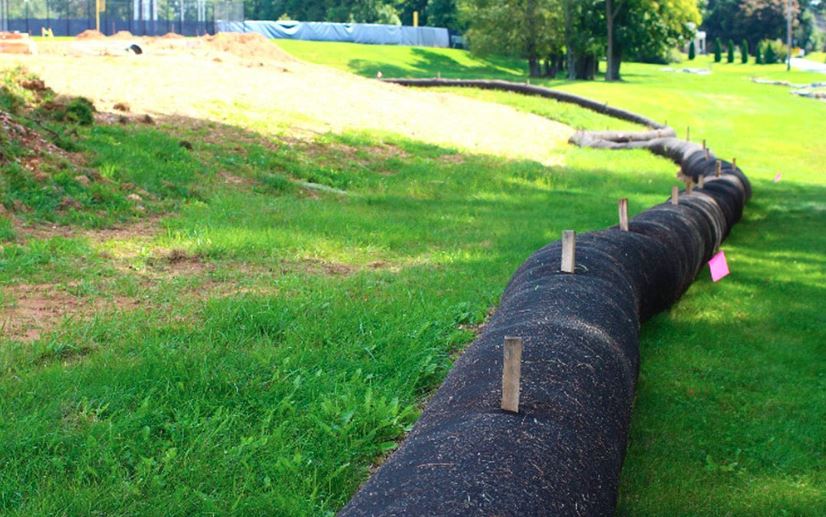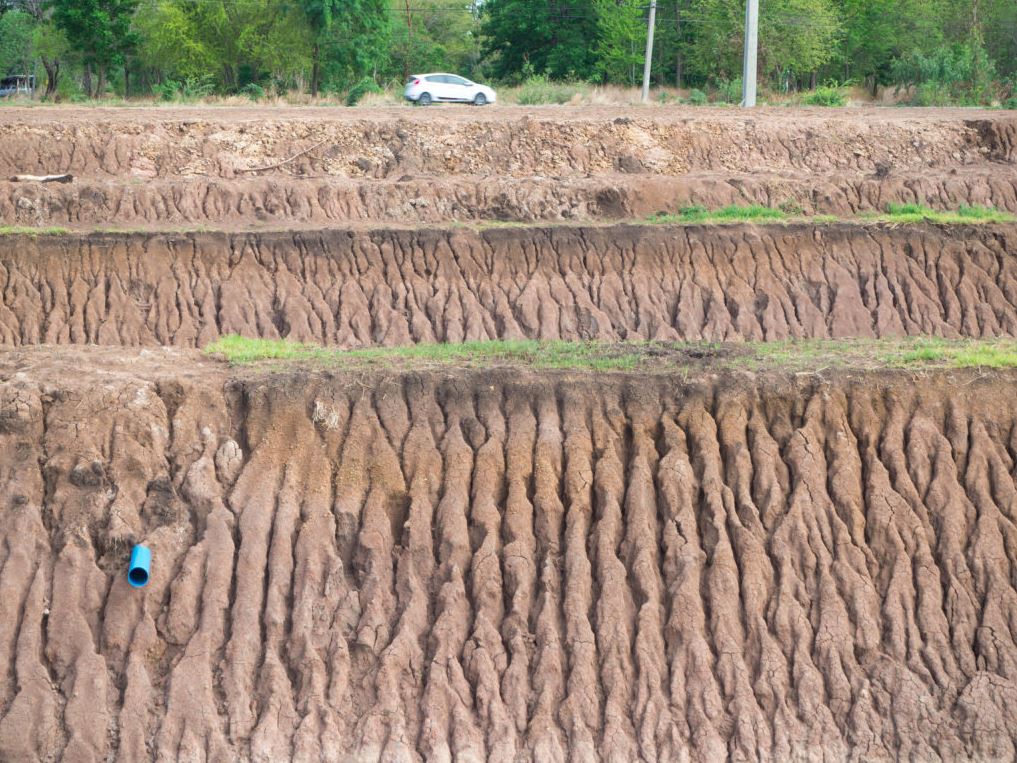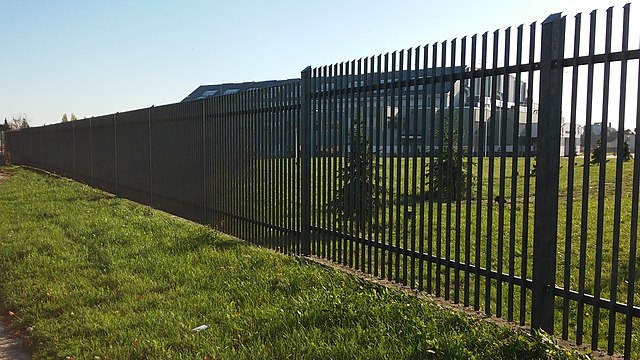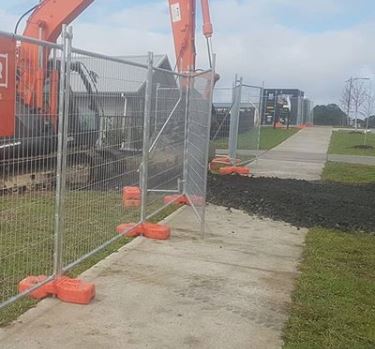Sustainable development involves an approach that considers environmental concerns along with economic progress. By definition, sustainability must meet the needs of the present without compromising the ability of future generations to meet their own needs. Erosion control tubes or silt sock are effective tools that can be used to reclaim degraded or eroded land.
Sediment from stormwater runoff is the leading source of surface water pollution. Most stormwater pollutants are soluble or in dissolved forms. Silt socks and erosion control tubes can help to mitigate soil erosion by filtering out a large amount of these pollutants.


What are erosion control tubes and what do they do?
A silt sock, also called an erosion control tube, is an efficient, low-tech erosion control tool for capturing hazardous sediments and halting soil erosion.
Silt socks are specially designed and manufactured fabric tubes that are filled with organic compost materials to effectively trap sediment and pollutants, particularly in areas with high vulnerability to stormwater runoff and erosion and can be an alternative, or in addition to, silt fence, erosion control blanket or erosion control matting.
They work in a variety of environmental conditions including slopes, building sites, and the banks and shorelines of rivers and streams to avoid turbidity and pollution. They may be easily tailored to fit practically any drainage region or watershed, taking the place of coir logs, straw wattles, silt fences, erosion control blankets, bales of straw, and rock check dams.
They do not damage the soil during installation or removal because they do not require trenching.
How are erosion control tubes installed and what are the best applications?
Silt socks allow water to flow through at a controlled rate while trapping sediment. This is accomplished by a filter fabric filled with organic material. The design of the sock provides contact with the ground preventing water from flowing underneath.
The sedimentation removal process associated with Silt Sock involves both filtering and deposition from settling. This is different than other methods using only ponding for deposition of sediment. Ponding occurs when water flowing to the Silt Sock accumulates faster than it can flow through the Silt Sock. However, installation technique is important for them to work effectively.
Silt Sock is used in any area requiring sediment control to keep runoff in the form of sheet flow. The use of erosion control tubes and silt socks are best applied to areas of high sheet erosion, on steep slopes up to and exceeding a 2:1 slope, and in other disturbed areas of construction sites requiring sediment control. Silt Sock may also be used in sensitive environmental areas, where migration of aquatic life is impeded by the use of other sediment controls. Filter media used in Silt Sock also have the ability to bind various contaminants contained in runoff.
Some construction sites need erosion control installed through trees, over asphalt or next to sidewalks. Urban sites and existing construction developments have limited space and ground conditions that are not ideal for trenching. This is when we suggest using Silt Sock erosion control tubes.
What are some of the benefits of using erosion control tubes on your property?
Cost Effective
Similar to a silt fence, a silt sock is an erosion control tool that stops soil erosion. A filter sock is often filled with wood chips or compost using a pneumatic method to maximize the quantity of material filler inside the sock rather than just plain fabric. Silt socks are often more affordable and adaptable than conventional silt fences or erosion control blankets for large projects.
Erosion control tubes are a very cost-effective solution for preventing soil erosion. They are much less expensive than other methods, such as concrete walls or rock barriers, and can be used in a variety of applications.
In addition, under some circumstances, they can be reused multiple times and are often recycled after use. With proper care and maintenance, they can last for many years, making them a very cost-effective solution for erosion control.
Easily Maintained
Silt Socks collect sediment while allowing water to flow through at a controlled rate. An organic material-filled filter cloth is used to achieve this. Unlike a silt fence, the sock’s shape allows for closer contact with the ground, which prevents water from running underneath.
Easy to Install
Erosion control tubes are easy to install, even for those with no previous experience. They can be placed by hand or with a machine, and require no special tools or equipment. Most importantly, they can be installed quickly and easily, without disrupting your normal routine.
In many places, filter socks can be utilized in place of silt fence. They are simple to distribute and install, flexible, and adaptive. A 100% recycled material is used in the environmentally friendly silt socks, filter socks, and erosion control wattles. This filler is inert, seed-free, has a low moisture content, and is extremely eco-friendly.
Improved Site Access
With a smaller profile and superior erosion control, the silt sock makes your project easier to reach and more aesthetically beautiful.
Reusable
Silt socks and erosion control tubes are by contractors in a variety of ways. Smaller diameter filter socks can be transported from one job site to another if properly cared for.
Soil Erosion Prevention
Erosion control tubes are an effective way to prevent soil erosion from stormwater runoff on your property. Trapping sediment and water, they help to stabilize the soil and prevent it from being washed away. This is especially important on slopes and in areas subject to high winds or heavy rains.

Are there any drawbacks to using erosion control tubes on your property, and if so, what are they?
Generally speaking, no – there are no real drawbacks to using erosion control tubes on your property. This is an effective and affordable solution for soil erosion and can help you to maintain the integrity of your land.
In some cases, you may need to secure the tubes in place with stakes or mesh, but this is usually only necessary in areas where there is a high potential for erosion (such as on a steep slope or near a river or stream). Additionally, while erosion control tubes are typically made from recycled materials, some argue that they still have a negative impact on the environment because they require energy and resources to manufacture.
Final Thought
Erosion control products like tubes and socks are an effective and affordable way to prevent soil erosion on your property by helping with stormwater management. Made from durable, UV-resistant material, they are easy to install and will last for years. When used in conjunction with other erosion control measures, such as vegetative buffers, they can help keep your property free from soil erosion.
Frequently Asked Questions
Q: What is a silt fence?
A: A silt fence is a temporary sediment control device used on construction sites to protect against water pollution. Erosion and siltation are the leading causes of water pollution in the United States, and construction activity is a major source of these polluting sediments. Silt fences are installed around the perimeter of a construction site or around other land-disturbing activities to act as sediment traps and detain sediment-laden runoff before it can enter stormwater drains or bodies of water.
Q: What is a silt sock?
A: A silt sock is a cylindrical mesh bag that is generally used to capture sediment from the bottom of a water body. It can be made of metal, plastic, or other materials. Silt Socks allow water to flow through at a controlled rate while trapping sediment. This is accomplished by a filter fabric filled with organic material.
Silt socks are commonly used by environmental consultants and scientists to collect sediment samples for analysis. They can also be used by homeowners or municipalities to clean up areas affected by flooding.
Q: What is an erosion control blanket?
A: An erosion control blanket, or Erosion Control Mat (ECM), is a geotextile fabric specifically designed to stabilize and protect soils from erosion. ECMs are made of synthetic fibers such as polypropylene, nylon, or polyester and are available in various weights and sizes.
They are commonly used on slopes to prevent soil loss due to water or wind erosion. ECMs can also be used to stabilize roadways, construction sites, and other areas where soil stabilization is needed.



